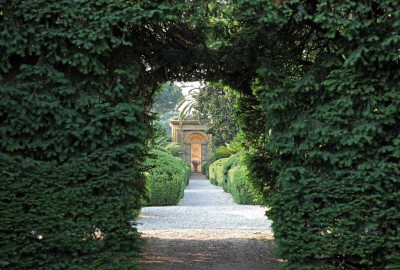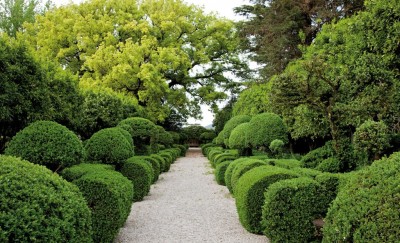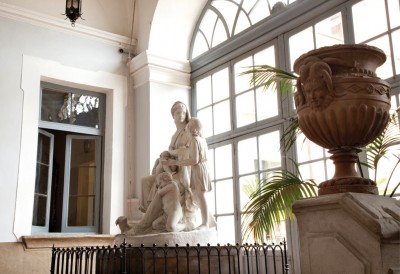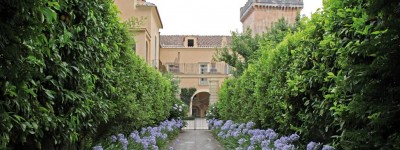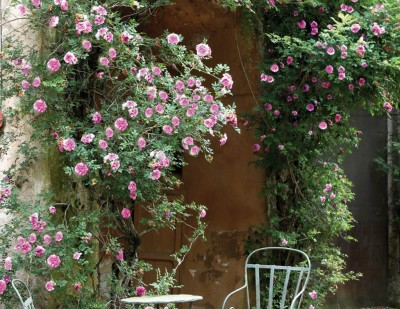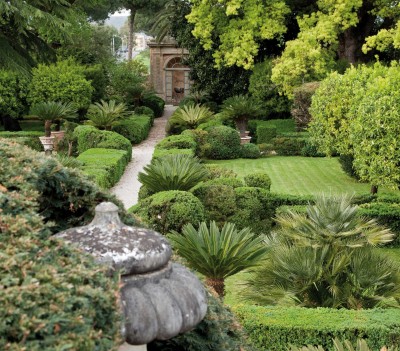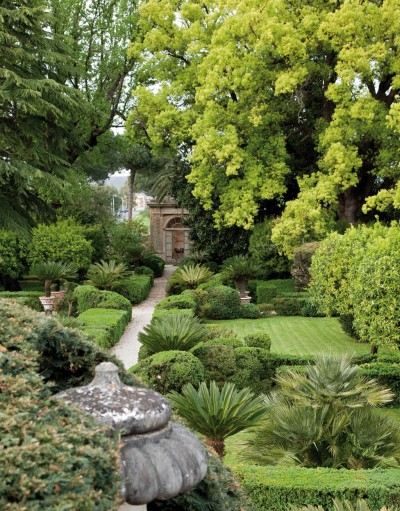Contact the abode
VILLA GUEVARA IN RECALE
The garden at Villa Guevara was created at the end of the 18th century at the behest of Duchess Anna Maria Suardo Guevara, Duchess of Bovino and lady-in-waiting to Maria Carolina, the Queen of Naples.
On 3 September, 1781, Ferdinand IV of Bourbon granted the privilege of a "carlino di acqua" or supply of water from the nearby waterfall of the Royal Palace of Caserta for the irrigation of his new garden, which was duly influenced by the design of the grounds of the Bourbon palace. The layout, extending over 1.7 hectares, was conceived and planned in accordance with the model and style of Italianate gardens. The focal point of the composition is theso-called ‘Viale degli Ombrellini’ (Umbrella Avenue), one of the most singular examples still existing of topiary art from the 18th century. Several decades later, the original geometric appearance was disrupted by the planting of camphor and tulip trees, which were left to grow freely with no seasonal pruning.
The combination of Italian discipline and English informality was perpetuated with the introduction of camellias and the ‘Acacia sensitiva’, also known as ‘Mimosa pudica’.
Successive landscape designs were to transform the pre-existing hunting forest, already two hundred years old at the time, into today's romantic and picturesque promenade.
Of particular botanical interest in the garden is the presence of a species of Camellia japonica called ‘Atroviolacea’, an exquisite early camellia with a beautiful purple colour, which is believed to be derived from the important collection of camellias cultivated in the nearby Royal Palace of Caserta.
THE HISTORY OF VILLA GUEVARA
The garden at Villa Guevara was created at the end of the 18th century at the behest of Duchess Anna Maria Suardo Guevara, Duchess of Bovino and lady-in-waiting to Maria Carolina, the Queen of Naples.
On 3 September, 1781, Ferdinand IV of Bourbon granted the privilege of a "carlino di acqua" or supply of water from the nearby waterfall of the Royal Palace of Caserta for the irrigation of his new garden, which was duly influenced by the design of the grounds of the Bourbon palace. The layout, extending over 1.7 hectares, was conceived and planned in accordance with the model and style of Italianate gardens. The focal point of the composition is theso-called ‘Viale degli Ombrellini’ (Umbrella Avenue), one of the most singular examples still existing of topiary art from the 18th century. Several decades later, the original geometric appearance was disrupted by the planting of camphor and tulip trees, which were left to grow freely with no seasonal pruning.
The combination of Italian discipline and English informality was perpetuated with the introduction of camellias and the ‘Acacia sensitiva’, also known as ‘Mimosa pudica’.
Successive landscape designs were to transform the pre-existing hunting forest, already two hundred years old at the time, into today's romantic and picturesque promenade.
Of particular botanical interest in the garden is the presence of a species of Camellia japonica called ‘Atroviolacea’, an exquisite early camellia with a beautiful purple colour, which is believed to be derived from the important collection of camellias cultivated in the nearby Royal Palace of Caserta.
FACILITIES AND SERVICES: PRIVATE EVENTS IN THE CAMPANIA REGION
Price for renting the entire property for a day, a week, or a weekend: to be agreed upon with the owners.
GUIDED TOURS
Visits can be organised for groups of a minimum of 20 people, including the guided tour and welcome drink. It is also possible to arrange breakfasts and lunches, rates to be agreed upon.
It is not possible to stay overnight in the Villa.
PLACES OF INTEREST IN THE VICINITY
Royal Palace of Caserta (Historic Apartments and Royal Park), the Carolino Aqueduct, Maddaloni in Caserta, Belvedere Royal Casino of San Leucio (Caserta), the Cathedral and Medieval Village of Casertavecchia, the Roman Amphitheatre and Mithraeum of Santa Maria Capua Vetere in Caserta, the Campano Provincial Museum in Capua, the City of Capua in Caserta, the Abbey of Sant'Angelo in Formis in Caserta, Palazzo Mondo (18th century historical residence), Capodrise (Caserta).
